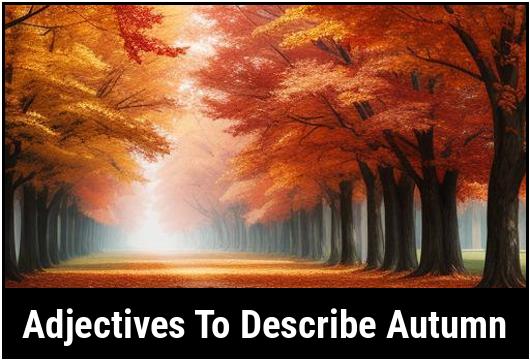- You are here:
- Home »
- adjectives
- » 31 Adjectives To Describe Autumn

31 Adjectives To Describe Autumn
Autumn, also known as fall, is a season of transition and change. It is a time when nature undergoes a remarkable transformation, painting the world in vibrant hues of red, orange, and yellow. As the leaves begin to fall, the air becomes crisp, and the days grow shorter, autumn brings a sense of nostalgia and introspection. Describing this captivating season often requires the use of evocative adjectives that can capture its essence and beauty. In this article, we will explore the various adjectives that can be used to vividly articulate the sights, sounds, and emotions of autumn.
Key Takeaways
- Autumn is a season characterized by a stunning display of colors, changes in weather, and a sense of transformation.
- Adjectives play a crucial role in conveying the ambiance and characteristics of autumn.
- Understanding the different types of adjectives can help in effectively describing the unique features of autumn.
Adjectives To Describe Autumn
1. Awe-inspiring
Autumn captivates us with its awe-inspiring beauty. The sight of trees adorned with vibrant hues of red, orange, and gold is truly breathtaking. The changing landscape invites us to embrace the wonders of nature.
2. Tranquil
As the days grow shorter, autumn ushers in a serene tranquility. The gentle rustling of leaves underfoot and the crisp, cool air provide a peaceful atmosphere that allows us to find solace in quiet reflection.
3. Picturesque
Autumn paints landscapes with picturesque scenes that seem to come alive. Each tree becomes a canvas, showcasing a magnificent blend of colors. It’s a season that begs to be captured on film, inspiring photographers and artists alike.
4. Cozy
Fall is synonymous with cozy. As the temperature drops, we wrap ourselves in warm blankets, indulge in cups of hot cocoa, and gather around crackling fires. The season implores us to embrace comfort and contentment.
5. Nostalgic
Autumn carries an undercurrent of nostalgia, reminding us of childhood memories and cherished moments. Whether it’s jumping into a pile of leaves or picking apples from a tree, this season evokes a sense of wistfulness and sentimentality.
6. Majestic
The grandeur of autumn is truly majestic. The towering trees, swaying gracefully in the wind, fill us with a sense of awe and wonder. The beauty of nature during this season is unparalleled.
7. Harvested
Autumn signifies the harvest season, when we reap the rewards of our hard work. The bounty of freshly harvested apples, pumpkins, and other crops serve as a reminder of the abundance of nature and the importance of gratitude.
8. Rustic
As the leaves begin to fall, autumn introduces a rustic charm to our surroundings. Nature dons earthy tones, creating a warm and inviting atmosphere. The essence of simplicity and natural beauty is intertwined with this season.
9. Romantic
There is a certain romance in the air during autumn. As the landscape transforms, it sets the stage for intimate walks, hand-in-hand, amidst colorful foliage. It’s a time when love and nature unite, evoking a sense of bliss.
10. Enchanting
Autumn casts an enchanting spell upon us. The crisp air carries whispers of mystery and magic. Walking through groves of trees, with leaves crunching underfoot, feels like stepping into a fairytale.
11. Timeless
Autumn is a season that transcends time. Its beauty and appeal remain constant, year after year. The changing seasons remind us of the cyclical nature of life and the eternal allure that autumn holds.
12. Vibrant
Autumn bursts forth with vibrant colors, bringing joy and energy to our surroundings. The palette of reds, oranges, and yellows inject life into every corner and ignite our senses with their radiant hues.
13. Crisp
Autumn ushers in a crispness to the air that invigorates our senses. The cool breeze tickles our skin and clears our minds, providing a refreshing and rejuvenating experience.
14. Mystical
With its foggy mornings and hazy landscapes, autumn has an aura of mystery surrounding it. It’s a season where reality and illusion intertwine, creating an atmosphere that ignites the imagination.
15. Flavorsome
The culinary delights of autumn are abundant and rich with flavor. From savory stews to pumpkin pies, the season tempts our taste buds with its hearty and comforting dishes.
16. Radiant
Autumn illuminates the world with its radiant beauty. Even on a gloomy day, the colors of the leaves seem to light up the atmosphere, filling us with warmth and joy.
17. Melancholic
While autumn brings beauty, it also tinged with a touch of melancholy. The falling leaves and the shorter days remind us of life’s transient nature, evoking a bittersweet feeling within our hearts.
18. Golden
Amidst the fiery reds and oranges, autumn blesses us with the golden glow of sunlight. The warm hues blanket the landscape, bringing a sense of harmony and serenity.
19. Harmonious
Autumn is a season that epitomizes harmony. The seamless blend of colors, the shifting temperatures, and the gentle rhythm of falling leaves create a sense of balance in both nature and our lives.
20. Invigorating
As we breathe in the crisp autumn air, we feel invigorated and alive. Our spirits are lifted, and our senses heighten, appreciating the small pleasures that the season brings.
21. Whimsical
The whimsy of autumn is woven into every aspect of the season. From the mischievous dance of leaves in the wind to the peculiar shapes they take on the ground, this time of year sparks our playful imagination.
22. Serendipitous
Autumn has a way of bringing unexpected joys into our lives. Whether stumbling upon a hidden path bathed in golden light or discovering a perfectly shaped leaf, the season offers serendipitous moments that fill our hearts with wonder.
23. Delightful
Every step we take in autumn is filled with delightful surprises. The crunch of leaves underfoot, the smell of cinnamon-spiced treats, and the anticipation of Halloween festivities all add to the season’s enchantment.
24. Magical
Autumn’s ability to weave magic into our lives is awe-inspiring. From witnessing trees transform before our eyes to experiencing the wonder of cozy evenings spent with loved ones, this season carries an undeniable sense of magic.
25. Transient
Autumn, much like life itself, is transient. Its brilliance and charm are fleeting, reminding us to cherish each moment. The changing scenery serves as a gentle reminder to appreciate the present and embrace the passage of time.
26. Welcoming
Autumn blankets us in a warm and welcoming embrace. Whether it’s the crunch of fallen leaves or the smell of pumpkin spice, the season invites us to slow down, savor the moment, and find comfort in its presence.
27. Reflective
As the pace of life slows down, autumn provides an opportunity for reflection. The quiet moments spent watching leaves fall or gazing at the starry night sky evoke a deep introspection, encouraging personal growth and self-discovery.
28. Resplendent
Autumn’s beauty is resplendent in its own right. The fiery colors of the leaves, the misty mornings, and the gentle sunlight create a tapestry that is rich with splendor and elegance.
29. Evocative
Autumn has the power to evoke a range of emotions within us. Whether it’s a sense of nostalgia, tranquility, or wonder, this season invites us to connect with our deepest sentiments and embrace the beauty around us.
30. Gracious
Like a graceful dancer, autumn lingers with elegance and poise. It graciously bids farewell to the vibrant summer and prepares us for the approaching winter, leaving behind memories and experiences to cherish.
31. Harmonic
Autumn orchestrates nature’s symphony in perfect harmony. The rustling leaves, the whispering winds, and the songs of migrating birds create a melodious soundtrack that ushers in a unique sense of peace and tranquility.
Why Use Adjectives To Describe Autumn
Adjectives are an integral part of language that serve to enrich our descriptions and evoke vivid imagery. When it comes to describing autumn, adjectives play a significant role in capturing the essence of this transitional season. By using descriptive adjectives, writers can convey the visual spectacle of autumn, the feelings it evokes, and the changes it brings. Additionally, adjectives can create a sensory experience for the reader, allowing them to immerse themselves in the sights, sounds, and emotions associated with autumn.
How To Choose The Right Adjective To Describe Autumn
When choosing adjectives to describe autumn, it is essential to consider the specific aspects of the season that one wishes to convey. Understanding the qualities and characteristics of autumn can guide the selection of adjectives that best encapsulate its essence. Whether it is the visual imagery of the changing foliage, the atmospheric sensations, or the emotional resonance of the season, selecting adjectives that resonate with these elements is crucial in effectively conveying the spirit of autumn.
Types Of Adjectives For Describing Autumn
Visual Adjectives
Visual adjectives are those that describe the appearance and aesthetics of autumn. These adjectives evoke the vivid colors and scenic beauty that define the season. Words like "vibrant," "golden," "crimson," "fiery," and "rustic" effectively convey the striking visual appeal of autumn. These adjectives paint a vivid picture of the landscape adorned with the warm hues of falling leaves and the gentle glow of the autumn sun.
Atmospheric Adjectives
Atmospheric adjectives capture the sensory experience of autumn, delving into the changing weather patterns and the palpable shift in the air. Words such as "crisp," "misty," "breezy," "frosty," and "dewy" evoke the tactile sensations associated with autumn. These adjectives transport the reader into the cool, refreshing atmosphere of autumn, where the earthy scents and brisk winds create a tangible ambiance.
Emotional Adjectives
Emotional adjectives are those that convey the sentiment and mood that autumn inspires. Words like "nostalgic," "introspective," "melancholic," "cozy," and "reflective" articulate the emotional depth and introspective nature of the season. These adjectives encompass the bittersweet allure of autumn, eliciting feelings of both comfort and wistfulness, as nature prepares for the impending winter.
Transformative Adjectives
Transformative adjectives encapsulate the profound changes that occur during autumn. Words such as "transitional," "metamorphic," "transient," "renewal," and "mellowing" characterize the season as a time of transition and renewal. These adjectives convey the metamorphosis of nature as it sheds its summer cloak and embraces a new phase, symbolizing both release and rejuvenation.
In essence, the use of adjectives is instrumental in articulating the vivid imagery, sensory experiences, emotional resonance, and transformative nature of autumn. By employing a diverse range of adjectives, writers can effectively convey the multifaceted beauty and complexity of this enchanting season. Whether painting a visual tableau of the autumn landscape, capturing the atmospheric ambiance, delving into the emotional undercurrents, or highlighting the transformative forces at play, adjectives serve as a powerful tool for capturing the essence of autumn. With the right adjectives, one can transport the reader into the enchanting world of autumn, allowing them to revel in its splendor and immerse themselves in its profound allure.
Examples Of Adjectives For Different Types Of Autumn
Autumn is a magical season that ushers in crisp air, vibrant colors, and a sense of change in the natural world. It is a time of transition and the perfect opportunity to capture its essence with descriptive adjectives. Adjectives play a crucial role in painting a vivid picture and evoking emotions when describing autumn.
-
Crisp: This adjective perfectly captures the refreshing quality of autumn air. It evokes a sense of coolness and clarity, as if each breath revitalizes the lungs.
Example: "The air in autumn is so crisp that it seems to cleanse my spirit with every inhale."
-
Vibrant: Autumn is known for its spectacular display of colors, and the adjective "vibrant" encapsulates this perfectly. It describes the bold and lively hues that emerge as the leaves change.
Example: "The vibrant red, orange, and yellow leaves create a breathtaking spectacle in the autumn landscape."
-
Golden: When leaves change color in autumn, they often take on a warm golden hue. This adjective conveys the richness and beauty of these golden tones.
Example: "The golden leaves carpeted the ground, transforming the landscape into a shimmering tapestry."
-
Rustic: Autumn is a season that brings with it a certain nostalgia and a connection to nature. The adjective "rustic" describes the earthy and countryside charm that is often associated with autumn.
Example: "The rustic charm of a cozy cabin in the woods is the perfect setting to appreciate autumn’s beauty."
-
Bountiful: Autumn is also a season of abundance, with harvests of fruits and vegetables reaching their peak. The adjective "bountiful" represents the plentiful and fruitful nature of this season.
Example: "Farmers’ markets showcase a bountiful harvest of pumpkins, apples, and gourds in autumn."
-
Misty: As autumn transitions into winter, misty mornings become more common. This adjective describes the ethereal and mysterious quality that fog and mist bring to the autumn landscape.
Example: "The misty mornings in autumn shroud the landscape in a mystical haze, adding an air of enchantment to the world."
-
Transitional: Autumn is a time of change and transition, both in nature and in people’s lives. The adjective "transitional" captures this sense of movement and transformation.
Example: "Autumn represents a transitional period between the warmth of summer and the cold embrace of winter."
-
Melancholic: There is often a sense of melancholy associated with autumn, as it marks the end of summer and the anticipation of winter. This adjective conveys the wistful and reflective mood that autumn can evoke.
Example: "As the temperature drops and the days grow shorter, a melancholic feeling settles in, reminding us of the fleeting nature of time."
-
Cosy: Autumn is a season that inspires feelings of comfort and warmth. The adjective "cosy" describes the snug and inviting atmosphere that autumn brings.
Example: "Curling up with a book and a warm cup of tea by the fireplace creates a cosy ambiance that is synonymous with autumn."
-
Fragrant: Autumn has its own unique scent, as fallen leaves, earth, and bonfires fill the air. The adjective "fragrant" captures these delightful aromas.
Example: "The fragrance of woodsmoke and damp earth hangs in the air, filling me with nostalgia for autumn."
Common Mistakes In Using Adjectives To Describe Autumn
While adjectives can greatly enhance the description of autumn, there are some common mistakes that writers should be aware of:
-
Overusing adjectives: It’s important to strike a balance when using adjectives. Overloading a description with too many adjectives can make it feel forced and detract from the overall impact.
Example: "The vibrant, golden, rustic, bountiful, misty, transitional, melancholic, cosy, fragrant atmosphere of autumn enveloped me." This sentence may feel cumbersome and excessive.
-
Using cliched adjectives: While some adjectives are commonly associated with autumn, it’s important to avoid relying solely on cliched descriptors. Instead, try to find fresh and unique words that truly capture the essence of autumn.
Example: Instead of using "crunchy" or "crispy" to describe fallen leaves, consider adjectives like "brittle" or "papery".
-
Misusing adjectives: It’s crucial to use adjectives accurately to convey the desired meaning. Misusing or misplacing adjectives can lead to confusion or convey unintended messages.
Example: "The melancholic apple pie reminded me of autumn." This sentence implies that the apple pie is sad rather than evoking a wistful feeling associated with the season. A better alternative could be "The fragrance of the apple pie brought back memories of a melancholic autumn."
To avoid these mistakes, it’s essential to carefully select and place adjectives in a way that elevates the description of autumn without overpowering or confusing the reader.
Using Adjectives Effectively
To use adjectives effectively when describing autumn, follow these tips:
-
Choose precise and specific adjectives: Select adjectives that accurately describe the characteristics of autumn, whether it’s the crispness of the air, the colors of the leaves, or the overall mood. Be specific in your choices to bring the description to life.
Example: Instead of using "nice," which is a vague adjective, try "brisk" to describe the autumn air or "blazing" to describe the colors of the leaves.
-
Use adjectives sparingly: While adjectives are useful tools for description, it’s important not to go overboard. By using adjectives sparingly, you give each one more emphasis and create a more impactful description.
Example: Instead of using multiple adjectives to describe a single leaf (e.g., "The vibrant, crisp, golden leaf"), focus on one or two adjectives that truly capture its essence (e.g., "The golden leaf").
-
Pair adjectives with sensory language: To create a more immersive experience for the reader, combine adjectives with sensory language to engage their senses. This allows them to visualize and feel the atmosphere of autumn.
Example: "The vibrant colors of the leaves danced in the afternoon sunlight, casting a warm and golden glow that enveloped the landscape."
-
Use figurative language: Adjectives can be enhanced by incorporating figurative language such as similes, metaphors, or personification. These literary devices add depth and richness to the description of autumn.
Example: "The leaves were a blazing tapestry, as if nature had set the trees afire with its artistic brushstrokes."
By following these tips, you can effectively use adjectives to create powerful and evocative descriptions of autumn.
Exercises And Practice
To enhance your skills in using adjectives to describe autumn, here are some exercises for practice:
-
Adjective brainstorming: Set a timer for five minutes and write down as many adjectives as you can think of that describe autumn. Let your imagination flow without judgment. Once the time is up, review your list and select the most evocative and unique adjectives.
-
Describe specific autumn scenes: Take a walk in nature during autumn and observe your surroundings. Choose a specific scene, such as a forest, a garden, or a park, and write a paragraph describing it using adjectives. Focus on painting a vivid picture and engaging the reader’s senses.
-
Edit and improve: Take a piece of your previous writing that describes autumn and highlight the adjectives used. Review each adjective and consider if there are any alternative choices that could enhance the description. Pay attention to avoiding cliches and misused adjectives.
-
Collaborative writing: Engage in a collaborative writing activity with a friend or a writing group. Each person takes turns writing a sentence that describes autumn using an adjective. Continue the exercise until you have created a beautiful paragraph filled with rich and diverse adjectives.
By practicing these exercises, you will refine your skills in using adjectives to describe autumn and develop a knack for creating engaging and vivid descriptions.
Conclusion
Adjectives are the spice that enhances descriptions of autumn, allowing us to capture the essence and beauty of this remarkable season. By choosing precise and specific adjectives, avoiding common mistakes, and using adjectives effectively, we can create immersive experiences for readers, evoking their senses and emotions. Take the time to practice and experiment with adjectives to paint a breathtaking picture of autumn that will stay etched in the minds of your readers.
FAQS On Adjectives To Describe Autumn
What Are Some Colorful Adjectives To Describe Autumn?
Some colorful adjectives to describe autumn are vibrant, striking, radiant, rich, and luminous.
How Can I Describe The Temperature Of Autumn?
The temperature of autumn can be described as crisp, cool, mild, refreshing, and invigorating.
What Are Some Words To Describe The Natural Scents Of Autumn?
Some words to describe the natural scents of autumn are earthy, woody, musky, spicy, and aromatic.
What Are Some Words To Describe The Changing Foliage Of Autumn?
Some words to describe the changing foliage of autumn are vibrant, fiery, golden, russet, and kaleidoscopic.
What Are Some Adjectives To Describe The Overall Atmosphere Of Autumn?
Some adjectives to describe the overall atmosphere of autumn are cozy, nostalgic, enchanting, peaceful, and bittersweet.








